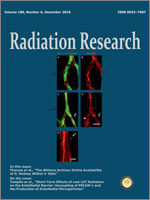The toxicity of tritium is a public health concern given its presence and mobility in the environment. For risk predictions using radiological protection models, it is essential to allocate an appropriate radiation weighting factor (WR). This in turn should be consistent with the observed relative biological effectiveness (RBE) of tritium beta radiation. Although the International Commission on Radiological Protection (ICRP) currently recommends a WR of 1 for the calculation of committed effective dose for X rays, gamma rays and electrons of all energies, including tritium energies, there are concerns that tritium health risks are underestimated and that current regulatory tritium drinking water standards need revision. In this study, we investigated potential cytotoxic and genotoxic effects in mouse spleen after one month and eight months of chronic exposure to low-dose tritiated water (HTO). The dose regimes studied were designed to mimic human chronic consumption of HTO at levels of 10 kBq/l, 1 MBq/l and 20 MBq/l. The total doses from these radiation exposures ranged from 0.01 to 180 mGy. We also compared the biological effects of exposure to HTO with equivalent exposure to external whole-body 60Co gamma rays. Changes in spleen weight and somatic intrachromosomal recombination (DNA inversions) in spleen tissue of pKZ1Tg/ mice were monitored. Our results showed no overall changes in either spleen organ weights and no increase mouse splenic intrachromosomal recombination frequencies, indicating that current drinking water standards for tritium exposure in the form of HTO are likely to be adequately protective against cytotoxic and genotoxic damage in spleen. These results demonstrate no evidence for cytotoxicity or genotoxicity in mouse spleen following chronic exposures to HTO activities (or equivalent gamma doses) up to 20 MBq/L.
How to translate text using browser tools
6 December 2016
Environmentally Relevant Chronic Low-Dose Tritium and Gamma Exposures do not Increase Somatic Intrachromosomal Recombination in pKZ1 Mouse Spleen
Laura Bannister,
Mandy Serran,
Lindsey Bertrand,
Dmitry Klokov,
Heather Wyatt,
Melinda Blimkie,
Yann Gueguen,
Nicholas Priest,
Jean-René Jourdain,
Pamela Sykes
ACCESS THE FULL ARTICLE

Radiation Research
Vol. 186 • No. 6
December 2016
Vol. 186 • No. 6
December 2016




